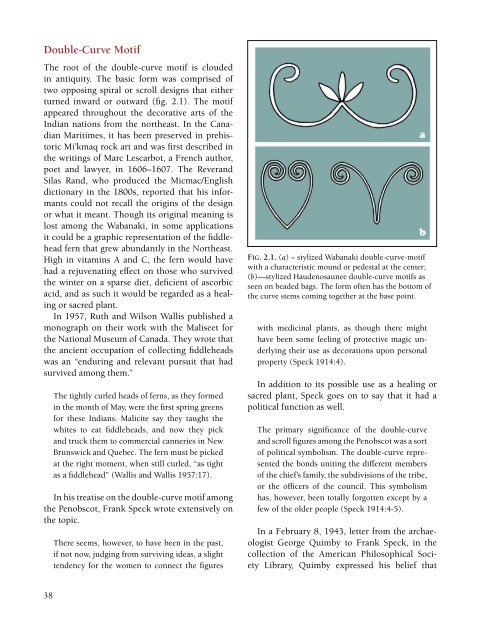A CHERISHED CURIOSITY - GERRY BIRON
A CHERISHED CURIOSITY - GERRY BIRON
A CHERISHED CURIOSITY - GERRY BIRON
You also want an ePaper? Increase the reach of your titles
YUMPU automatically turns print PDFs into web optimized ePapers that Google loves.
Double-Curve Motif<br />
The root of the double-curve motif is clouded<br />
in antiquity. The basic form was comprised of<br />
two opposing spiral or scroll designs that either<br />
turned inward or outward (fig. 2.1). The motif<br />
appeared throughout the decorative arts of the<br />
Indian nations from the northeast. In the Canadian<br />
Maritimes, it has been preserved in prehistoric<br />
Mi’kmaq rock art and was first described in<br />
the writings of Marc Lescarbot, a French author,<br />
poet and lawyer, in 1606–1607. The Reverand<br />
Silas Rand, who produced the Micmac/English<br />
dictionary in the 1800s, reported that his informants<br />
could not recall the origins of the design<br />
or what it meant. Though its original meaning is<br />
lost among the Wabanaki, in some applications<br />
it could be a graphic representation of the fiddlehead<br />
fern that grew abundantly in the Northeast.<br />
High in vitamins A and C, the fern would have<br />
had a rejuvenating effect on those who survived<br />
the winter on a sparse diet, deficient of ascorbic<br />
acid, and as such it would be regarded as a healing<br />
or sacred plant.<br />
In 1957, Ruth and Wilson Wallis published a<br />
monograph on their work with the Maliseet for<br />
the National Museum of Canada. They wrote that<br />
the ancient occupation of collecting fiddleheads<br />
was an “enduring and relevant pursuit that had<br />
survived among them.”<br />
38<br />
The tightly curled heads of ferns, as they formed<br />
in the month of May, were the first spring greens<br />
for these Indians. Malicite say they taught the<br />
whites to eat fiddleheads, and now they pick<br />
and truck them to commercial canneries in New<br />
Brunswick and Quebec. The fern must be picked<br />
at the right moment, when still curled, “as tight<br />
as a fiddlehead” (Wallis and Wallis 1957:17).<br />
In his treatise on the double-curve motif among<br />
the Penobscot, Frank Speck wrote extensively on<br />
the topic.<br />
There seems, however, to have been in the past,<br />
if not now, judging from surviving ideas, a slight<br />
tendency for the women to connect the figures<br />
fig. 2.1. (a) – stylized Wabanaki double-curve-motif<br />
with a characteristic mound or pedestal at the center;<br />
(b)—stylized Haudenosaunee double-curve motifs as<br />
seen on beaded bags. The form often has the bottom of<br />
the curve stems coming together at the base point.<br />
with medicinal plants, as though there might<br />
have been some feeling of protective magic underlying<br />
their use as decorations upon personal<br />
property (Speck 1914:4).<br />
In addition to its possible use as a healing or<br />
sacred plant, Speck goes on to say that it had a<br />
political function as well.<br />
The primary significance of the double-curve<br />
and scroll figures among the Penobscot was a sort<br />
of political symbolism. The double-curve represented<br />
the bonds uniting the different members<br />
of the chief’s family, the subdivisions of the tribe,<br />
or the officers of the council. This symbolism<br />
has, however, been totally forgotten except by a<br />
few of the older people (Speck 1914:4-5).<br />
In a February 8, 1943, letter from the archaeologist<br />
George Quimby to Frank Speck, in the<br />
collection of the American Philosophical Society<br />
Library, Quimby expressed his belief that


